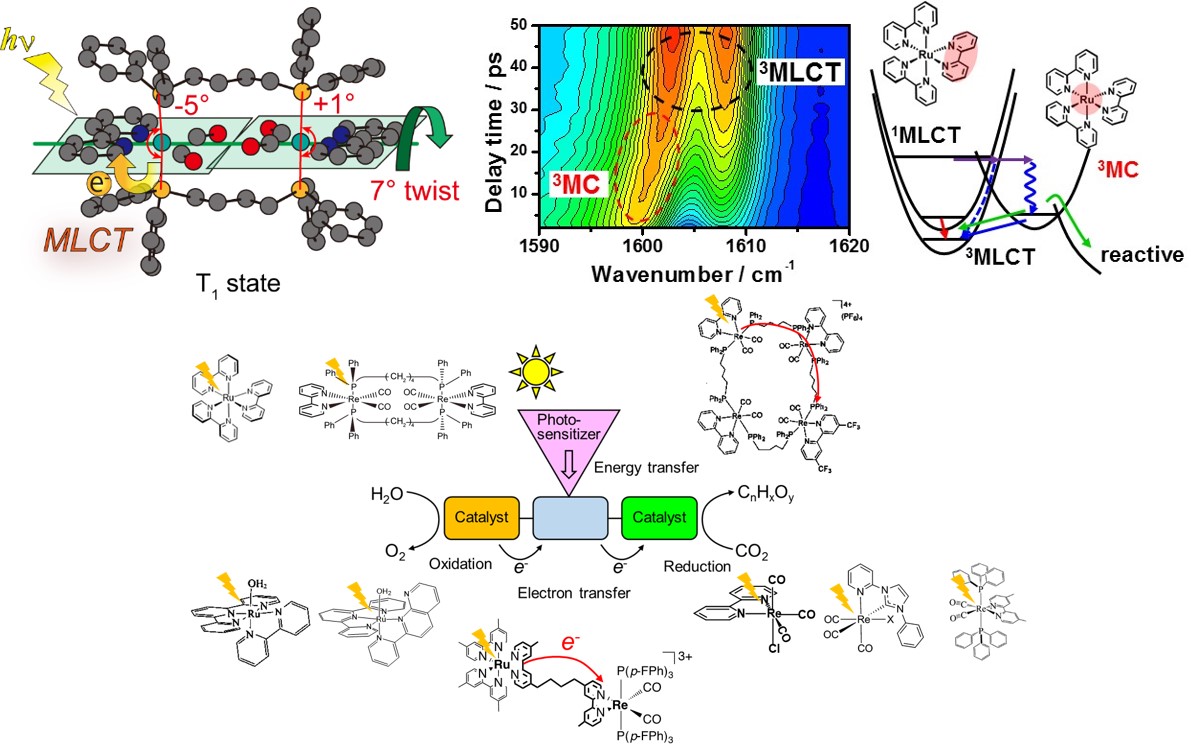Research
Realtime observation of chemical processes using time-resolved spectroscopy
Chemistry is the scientific study on transformation of materials; however, it is generally difficult to track the transformation processes in realtime and we usually infer the processes from the examination before and after the transformation. This is because molecular transformation takes place very quickly via non-thermal equilibrium states, which is difficult to treat with theories in physics. Nevertheless, if such processes can be precisely analyzed in realtime, our knowledge of chemical reactions and functional materials would be much better and their designs would be much easier. To this end, we have been developing a variety of ultrafast spectroscopic systems which enable us to observe the processes in realtime in many important materials in terms of basic science and applications and challenging to elucidate the processes in these materials in detail. Below, our recent research topics are briefly introduced.

Organic luminescent materials
Organic compounds made of light elements such as carbon, oxygen, and sulfur can be easily designed and exhibit a variety of optical functions, for example, thermally activated delayed fluorescence and room-temperature phosphorescence. Their mechanisms are, however, very complicated and are not easily revealed. Using our time-resolved infrared vibrational spectroscopy and other complementary measurement systems, we are exploring their photo-excited processes in solution and in solids in terms of structural dynamics.


[References]
- M. Saigo, et al. J. Phys. Chem. Lett., 10, 2475-2480 (2019).
- Y. Shimoda, et al. J. Chem. Phys. 153, 204702 (2020).
- R. Koninti, et al. J. Phys. Chem. C, 125, 17392-17399 (2021).
- T. Ryu, et al. Chem. Phys. Lett. 809 140155 (2022).
Rare earth emitters
Since trivalent lanthanide ions exhibit luminescence with high color purity derived from the 4f-4f transitions, they are expected to be used as luminescent materials in various applications. In order to obtain efficient emission from lanthanides with low absorption coefficients, highly efficient luminescent complexes using energy transfer from organic ligands with high absorption coefficients have been developed. Nevertheless, their luminescence mechanisms are elusive and design strategies for highly efficient luminescent complexes have not been established yet. We are challenging these problems using our various ultrafast spectroscopy systems.

[References]
- S. Miyazaki, J. Phys. Chem. A, 124, 6601-6606 (2020).
Transition metal complexes
Transition metal complexes are widely used in photofunctional materials, such as artificial photosynthesis, organic solar cells, fluorescent probes, and organic photosynthesis, as key components. We have been investigating the photo-excited processes in these metal complexes using mainly time-resolved infrared vibrational spectroscopy and revealing a lot of fundamental processes that play important roles in functional materials.

[References]
- T. Mukuta, et al. Inorg. Chem. 53, 2481 (2014).
- S. Tanaka, et al. J. Photochem. Photobio. A: Chem. 313, 87 (2015).
- T. Mukuta, et al. ChemistrySelect, 1, 2802 (2016).
- S. Tanaka, et al. Chem. Phys. Lett. 662, 120 (2016).
- T. Mukuta, et al. Inorg. Chem. 56, 3404 (2017).
- Y. Shimoda, et al. Inorg. Chem., 60, 7773-7784 (2021).


